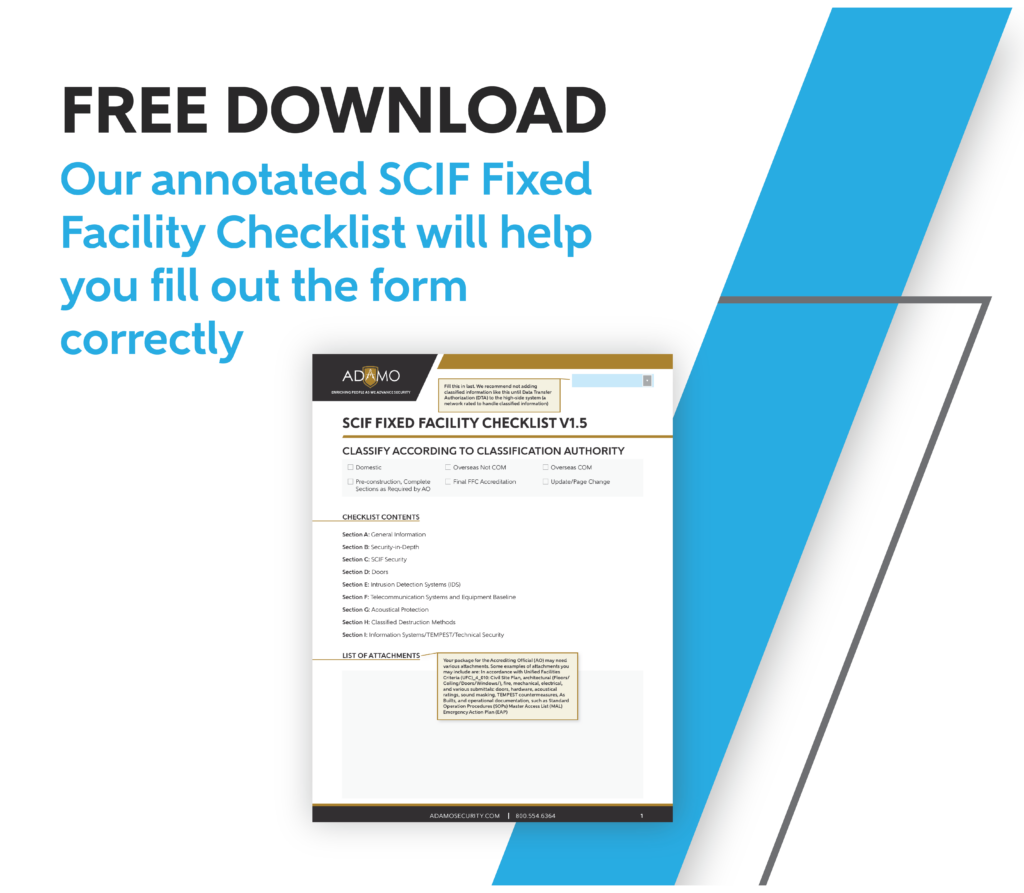An overview and tips to help you complete your FFC
For any SCIF or SAPF construction projects, the ICD 705 Technical Specifications, or Tech Spec, requires that the Site Security Manager (SSM) completes a Fixed Facility Checklist (FFC) and submits it to the Accrediting Official (AO). This is a form that needs to be completed in full for every project seeking accreditation under the ICD 705. Your SSM can be an in-house employee, or you can outsource them.
The form is 21 pages long and requires a comprehensive knowledge of the project to complete. Because of this, you will likely need to seek outside sources to answer some of the questions on the form, and it cannot be fully completed by outsourced help, as it requires some knowledge of the program that will occupy the space. Your SSM may be filling multiple roles, including Facility Security Officer (FSO), which would likely mean they have a greater scope of knowledge of the project and program.
Pre-Construction
You will complete at least two drafts of the FFC to send to the AO. The AO needs the first draft during the design phase as part of the design approval process. This section will be easiest to fill out when the designs are around two-thirds of the way done, since a lot of the questions will be answered at this stage, but it still allows time to make changes if the AO requests them.

During this phase, you’ll be able to answer questions including if ventilation ducts will penetrate the SCIF, what the perimeter wall construction will be, and if the facility will have any secondary doors. The FFC can, in part, be filled out by an outsourced SSM, and these questions will be ones they can answer since they will be familiar with the plans. Whoever you have completing these questions needs to be able to read and understand design plans.
There are sections of the FFC where the questions may be unanswered at this stage, or you may not know the answer to if you are not the end user group, such as if the facility will have unclassified telephones or how classified information will be destroyed. Answer as much as you can, but the AO may come back and ask you to find answers for sections you didn’t previously complete. At that point, you would have to find who can answer those questions or make decisions earlier than you had planned. You may also have to make changes to the design if there’s anything the AO isn’t happy with. These questions may be able to be answered by people like the designer of record, general contractor or end user FSO.
At the end of the FFC there is a question: “Does the facility electronically process classified information?” If the answer is yes—which it most likely will be—you must also complete the TEMPEST addendum. This form covers any TEMPEST concerns, including power lines, penetrations like HVAC systems and pipes, and radio transmission devices. This form will be completed and turned into the AO alongside the FFC.
Post-Construction
If the AO doesn’t request any revisions, you will submit your second FFC draft once construction is completed. You will have to fill it out completely at this point as well as include any changes that occurred from your initial plan to the finalized construction. In order to make this as easy as possible, make sure you keep detailed notes of any deviations from the initial design, such as changes in wall construction or locations of penetrations.
For the questions you personally don’t know the answers to, you’ll have to seek out the answers. The IT department may know more answers about the telecommunications of the facility, and the end-user FSO should know about how classified information destruction will be handled. The Designer of Record or general contractor can answer construction-related questions. Because some of this information pertains to the operations of the program, outsourced help won’t be able to complete some of these sections of the FFC.
While the FFC is a relatively straightforward document, there is a lot of knowledge of the project required to complete it. If you’re looking for help with the FFC, other SCIF and SAPF documents or any part of your project’s construction, Adamo consulting can help. Our experts can partner with your team and help you navigate and overcome any challenges from design through to accreditation.




